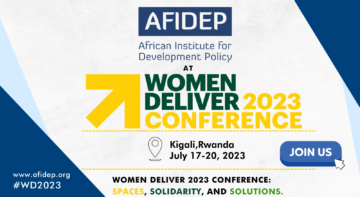News

The 2015 Demographic Dividend Knowledge Sharing Symposium for East and Southern Africa, the first-ever, was what I would call a “meeting of minds’. Development experts drawn from government agencies, research institutions, development agencies and the private sector from 15 African countries converged in Nairobi from 24th to 26th August 2015 at the Safari Park Hotel in Nairobi, Kenya, for a 3-day knowledge sharing experience co-hosted by the National Council for Population and Development (NCPD), United Nations Population Fund (UNFPA) Kenya and the African Institute for Development Policy (AFIDEP).
It would be right to say that the conversation on Africa’s development has come of age so to speak, as this was a forum by Africans, for Africans, discussing solutions to African problems.
Demographic dividend not a new concept
“The demographic dividend is not a new concept.” This was a statement playing on the lips of several speakers at the event. And they are right. Governments have been implementing programmes to tackle challenges in health, education, economic reforms, and governance for a long time. However, the shift in the “DD’ conversation is that all these areas of socioeconomic growth are seen as a unit. “Pillars’ or “wheels’ as population experts prefer to call them. The wheels must move together for the entire system to achieve the desired result, which is a developed Africa. In short, governments must make investments to facilitate empowerment of women and reduction in fertility and concurrently increase investments in health, education, the economy, and governance, simultaneously, so that African countries can experience the socioeconomic transformation we crave.
So what is the demographic dividend? It is the accelerated economic benefit that arises from a significant increase in the ratio of working-age adults relative to young dependents (which results from sustained decline in birth and death rates). As explained by Dr Eliya Zulu, AFIDEP Executive Director, the starting point for harnessing the demographic dividend is to accelerate decline in fertility through sustained investments in family planning, child survival and schooling of girls, which will delay early marriages and teenage childbearing. However, in order for the country to earn a maximum demographic dividend, simultaneous investments need to be made in education, skills development, public health, governance, and inclusive economic growth and job creation.
The demographic dividend wheels: Adapted from African Union Commission, 2013
The current Africa scenario
Following presentations on how the collaboration between Governments, UNFPA, and AFIDEP is striving to drive the demographic dividend agenda across Africa, it is encouraging that policymakers more so Heads of States are beginning to develop traction towards the demographic dividend concept. For instance, in July 2015, during a meeting with UNFPA officials (that included AFIDEP), Malawi’s President Arthur Mutharika called upon development experts and pledged to do his best to make the right investments to transform the lives of Malawians along the demographic dividend perspective. In July 2014, President Yoweri Museveni of Uganda also acknowledged the need for a change in tact for his government to realise the goals of the country’s Vision 2040. Presidents Uhuru Kenyatta and Macky Sall of Kenya and Senegal respectively, have also been appointed as demographic dividend champions for their respective countries. Studies seeking to outline the prospects and chart a road map for countries to harness the demographic dividend have been conducted in Uganda, Zambia, Mozambique, Botswana and Malawi. President Edgar Lungu of Zambia has strongly supported the demographic dividend work and he will be launching the study report for his country soon.
Based on the various case studies conducted by countries participating at the Symposium, it is clear that African countries have bought into the demographic dividend philosophy and they are anxious to make investments in the various areas highlighted as key for national growth.
Demographic dividend in the post-2015 development agenda
According to Mr. Constant-Serge Bounda, Chief, UNFPA Liaison Office to African Union Commission (AUC) and United Nations Economic Commission for Africa (UNECA) who spoke at the Symposium’s opening, the objective is for the demographic dividend to be recognised in the global intergovernmental processes occurring in this special year of 2015. He noted that the Common African Position (CAP) on the post-2015 development agenda clearly stipulates the need to harness the demographic dividend. Specifically, paragraph 48 states: “to ensure that Africa’s youth bulge is translated into demographic dividend“. The African Union Agenda 2063, described as “a shared strategic framework for inclusive growth and sustainable development & a global strategy to optimise the use of Africa’s resources for the benefits of all Africans” also has it. Aspiration 6 states: “An Africa whose development is people-driven, relying on the potential of African people, especially its women and youth, and caring for children.”
The negotiations that recently concluded in New York on the Post-2015 Development Agenda have also recognised the demographic dividend as a major issue for ensuring sustainable development, not forgetting that 4 of the 17 sustainable development goals (SDGs) are related to youth, who are a key anchor for a demographic dividend to be realised:-
- Goal 3: Ensure healthy lives and promote well-being for all at all ages;
- Goal 4: Ensure inclusive and equitable quality education and promote life-long learning opportunities for all;
- Goal 5: Achieve gender equality and empower all women and girls;
- Goal 8: Promote sustained, inclusive and sustainable economic growth, full and productive employment and decent work for all;
Across the board, development experts are now embarking on concerted efforts to speak in one voice on the demographic dividend. UNFPA in partnership with AFIDEP is leading in advocacy and political outreach across Africa, and the inclusion of youth elements in the SDGs is already a success. The demographic dividend has also been declared the theme for the 2017 African Union Summit.
After the Symposium, now what?
Following three days of rigorous discussions on the experiences of the participating countries striving to move their economies towards socioeconomic transformation, it was important that the next steps are solid. Consequently, a 10-pronged path was suggested:
- National demographic dividend programmes should be embraced at the highest level of leadership and managed by the government institution responsible for coordinating development programmes to ensure ownership and accountability at all levels of government and among stakeholders and citizens.
- Governments should create an enabling environment to foster growth of and participation of the private sector and other stakeholders, including youth, in furthering the demographic dividend agenda.
- There should be a comprehensive review of current demographic dividend wheels and the associated modelling, costing and planning tools in line with different national socioeconomic and demographic contexts across Africa.
- Develop regional and national roadmaps for implementing demographic dividend activities with robust frameworks and indicators for monitoring progress and enforcing accountability.
- There should be comprehensive mapping and documentation of specific high impact game-changer interventions and innovations for each demographic dividend pillar based on proven positive experiences from East Asia, Latin America and African countries.
- The demographic dividend agenda should be integrated in development plans at regional, national, and sub-national levels and anchored in the Agenda 2063 and SDG frameworks to ensure sustained prioritisation, resource allocation and implementation of demographic dividend interventions.
- Strengthen regional coordination mechanisms and linkages among demographic dividend initiatives at the African Union, regional, national and sub-national levels to ensure consistent responses.
- Operationalise an Africa-wide demographic dividend knowledge sharing forum to facilitate exchange of experiences, best practices, policy-oriented evidence, and capacity development among all stakeholders working on the topic, including policymakers, development partners, funders, researchers, the private sector, and youth groups.
- Develop clear communication and advocacy strategies to ensure common and consistent understanding of the demographic dividend concept and what needs to be done for countries to harness it
- Enhance technical capacity of research and academic institutions, policymakers, and other stakeholders in generating, translating and using demographic dividend evidence in priority setting, integrated planning and programme implementation.
With the roadmap clear, it is now time for governments and other stakeholders to get down to work. And, it is critical to remember that the demographic dividend is a window of opportunity that can be missed. Let Africa maker the right people-centred investments in order to take advantage of the rapidly growing youth bulge. As for the Symposium, it was a great conversation starter and a forum whose ultimate measure of success will be the extent to which participating and other African governments will walk the talk to incorporate this development paradigm in key development strategies to realise the socioeconomic transformation envisaged in Agenda 2063 and national long-term development visions.
Read related story on the Symposium opening here
Related Posts






